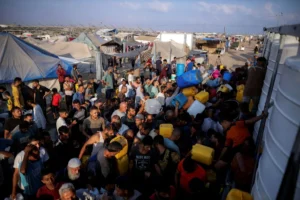A Full Reoccupation of Gaza Won’t Keep Israelis Safe. It Will Only Fan the Flames

Palestinians displaced by the Israeli bombardment of the Gaza Strip queue for water at a makeshift tent camp in the southern town of Khan Yunis, on Monday
Zvi Bar’el writes in Haaretz
“Israel has effectively lost sovereignty in the northern quadrant of its country because people don’t feel safe to go to their homes,” said U.S. Secretary of State Antony Blinken in an interview at the Brookings Institution in Washington this week. “And absent doing something about the insecurity, people won’t have the confidence to go back,” he concluded.
Residents of the north and the rest of Israel’s citizens don’t need Blinken’s pointed diagnosis. They experience it personally. But if the criterion for practical sovereignty is the ability of citizens to live in their homes with total security, dependent on their trust that the state will provide it, then sovereignty in the southern part of this country is far from perfect as well.
For most of its history, Israel had relied on the strategy of building communities along its borders, as well as building settlements in territory taken through conflict, and providing deterrence to its enemies with fortified bases along the frontiers, to create this sovereignty.
With the 1973 Yom Kippur War, this was put to the test as new settlements in the Golan Heights were evacuated at IDF orders, as were many settlements in the West Bank at the initiative of settlers.
The 2005 disengagement from Gaza made it clear that settlements alone do not provide the ‘security belt’ that they were considered to, as the massive presence of soldiers protecting the 8,000 settlers in Gaza did not prevent attacks or create deterrence. This concept, of settlements and border communities as security insurance, was then fully shattered beyond repair with October 7.
With the recapture of the Gaza Strip, Israel wishes to revive this conception, but in reverse. First, the enemy must be neutralized, restoring the sense of security and the trust of people uprooted from their homes. Only then can the eroded sovereignty be re-established. In contrast to previous wars, this time the government and the IDF are forgoing the need for deterrence as a condition for security, by destroying the element that needs to be deterred.
In other words, without Hamas there is no threat, and in the absence of a threat, deterrence is redundant. This strategy is meant to create a new situation in which the IDF will only have to “maintain” the Gaza Strip in order to prevent the development of a new threat. This “maintenance” already has a practical expression on the ground.
This involves controlling 26 percent of the Gaza Strip’s territory, as exposed in a Haaretz Hebrew edition investigative report. Israel has divided the Gaza Strip into two, with the wide east-west Netzarim corridor which includes army bases along its length, and has created significant buffer zones, both between Gaza and Israel along its entire length, and along the Gaza-Egypt border, with the Philadelphia corridor.
